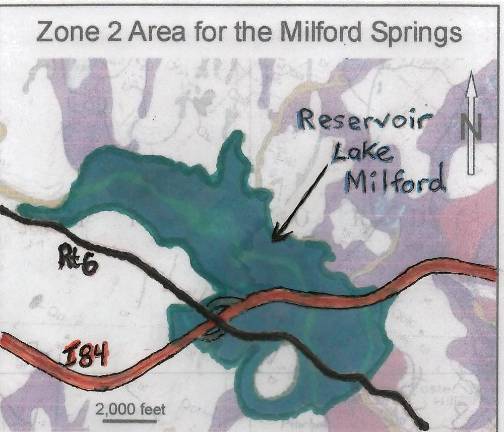
To the Editor:
I want to make you aware that the Milford Springs are in danger from an expansion of an RC Zone in Dingman Township All Information needed to understand this issue is in my Public Comment on this issue. After the recent selling of land on this aquifer, this is the largest piece to be developed but this is just the beginning. I believe more will follow soon. Maps are added to further the highlight the danger.
In 1966, when the Pennsylvania Department of Transportation (PennDOT) was building the I-84/Rt.6 interchange, they discovered a detrimental impact on the Milford Springs. They responded by adjusting its building practices; however, the interchange remained and is placed directly on Zone 2 of the Milford Springs — the most sensitive part of the aquifer.
This interchange creates a magnet for Commercial Development, but what happens when that same land is also intensely related to the purity of a town’s drinking water? This is not just a legal issue of sorting out competing claims to the same land, but a moral issue as well. The Milford Springs is a geological construct that took 200,000 years to form. This interchange is an arbitrary construct of PennDOT that happened by accident. What construct do you think has the most legal standing in a dispute? I think Gifford Pinchot said it best: conservation means “the greatest good to the greatest number for the longest time.” This should be the guiding principle for this land, but that is not how it has always played out.
In 1989, a huge mall was proposed for this interchange. A chemical tracer test was done which found the mall land and the Milford Springs were directly connected. This combined with the Sawkill Creek status being changed from High Quality to Exceptional Quality, effectively killing the mall project.
In the mid-1990s, a gravel pit mining operation only 2,800 ft. from the Milford Springs showed that the springs could experience turbidity in as little as eight hours. The Milford Water Authority (MWA) effectively shut down the mining operation and then bought the land outright and placed it into a conservation easement.
In 2000, they tried again by proposing to put Home Depot right on top of the Milford Aquifer. It was demonstrated by the MWA hydrologist that any chemical disaster at the Home Depot site would be an existential threat to the springs. This, along with community activism, stopped this ill-advised proposal.
In 2004, Dingman Township proposed a large Resort Commercial Zone at this same interchange. Most of this RC Zone passed in 2006. However, the new emerging science from the MWA Source Water Protection Plan of 2005, along with other Pike County political forces, lead to the positive breakthrough of Dingman Township adopting the Sawkill Creek Ordinance of 2006. This set up a strong legal framework for the protection of Milford Springs
In 2018, the MWA, along with a cooperative Dingman Township, crafted an even stronger legal framework to protect the springs when they updated and amended the Sawkill Creek Ordinance.
Now, in 2021, an expansion of the RC Zone at this same interchange is requested. This would create a larger RC Lot of 93.74 acres — 17.74 acres of which lay directly on Zone 2 of the Milford Springs. This proposed zone is only 3,900 ft. from the springs. The Sawkill Creek Ordinance is constructed around the legal standing that the MWA has to protect this 200,000 year old geological formation. Now, once again, the rights of a community to pure water is bumping up against the legal standing of developer rights.
I believe a deeper perspective is needed for this dilemma. Should it not be a moral obligation for a developer to at least consider the long-term effects of their actions on the community. The Native Americans understood that water is the eternal element that binds all living things to the Creator Spirit. Not all land should be squeezed for every penny it can produce. Some lands are sacred and essential to humans beyond money.
I propose a more permanent solution. I call for a renewed campaign by prominent stakeholders to try to persuade property owners and developers to consider conservation easements for some of their land that lays on top of the Milford Aquifer. This can be done through the generosity of the developer and the desire to leave a lasting legacy for the community, or it could be done through available governmental grants or entities like the Delaware Highlands Conservancy. As Tom Hoff from the MWA said in 2006 “it is easier to buy the land than to fix the springs.”
In honor of all the people who have fought for the purity of this water, I believe we owe it to them and for posterity, that we turn over every stone and try every method so that the Milford Springs survives another 200,000 years.
For more information or further discussion please contact me at: panda1999@verizon.net
Vito DiBiasi
Dingman Township